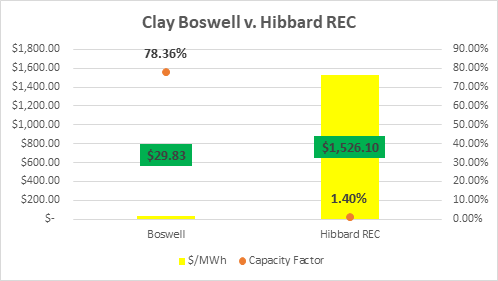Minnesota Keeps Shutting Down Inexpensive Power Plants: Why Not Expensive Renewable Energy Centers?
In recent years, Minnesota has retired some of the most efficient power plants in the state, including Black Dog, High Bridge, Riverside, Taconite Harbor, Syl Laskin, and Hoot Lake – all of which provided electricity for under $35 per MWh, according to data collected from the United States Federal Energy Regulation Commission (FERC).
By closing these plants, Minnesota is shutting down power plants that can produce a lot of affordable electricity and replacing them with incredibly inefficient power plants that are far more expensive.
This is especially the case for Minnesota Power’s Hibbard Renewable Energy Center (REC).
The Hibbard REC was designed to burn renewable wood-waste biomass fuel as part of Minnesota Power’s EnergyForward campaign to add more renewables into its energy mix. According to a Minnesota Power investor report issued in 2009, the utility would invest approximately $20 million to upgrade the boilers at the Hibbard REC so the plant could generate 200,000 MWh of electricity per year, compared to 70,000 MWH without the upgrade.
However, according to the FERC data, the Hibbard REC has actually cost nearly $100 million in capital expenses to date, five times more than they anticipated in 2009.
Although Hibbard REC managed to generate 163,000 MWh in 2010, that was a one-hit-wonder, apparently. The power facility has yet to reach higher than 36,000 MWh in a year since. In fact, the power plant only produced 7,500 MWh of electricity in 2016 at an alarming cost of $1,526 per MWh.
As Minnesota Power explained, Hibbard REC was built to produce far more electricity than it has been, and because it’s not producing at those levels, the cost per MWh is extremely high. In other words, Minnesotans are paying millions of dollars for a plant operating at less than 5% of what it was designed to generate electricity at.

Figure 1 The capacity factor represents a power plants usage. Hibbard REC was only used to generate electricity 1.4% of the time it could have in 2016.
This graph compares Hibbard REC to the Minnesota Power’s coal-fired power plant, Clay Boswell. Clay Boswell generated 883 times the amount of electricity produced by Hibbard REC in 2016 and was able to provide this electricity at prices lower than $25 per MWh. Instead of investing millions of dollars on expensive and inefficient renewable energy plants like Hibbard REC, Minnesota Power should simply utilize Clay Boswell and other affordable plants more often.
The cost of operating Hibbard REC is so high that Minnesota Power no longer considers it worth mentioning in resourcing planning because there are “more cost-effective resources that are being dispatched to balance the system before these units.”
After calling out Minnesota Power for not including the Hibbard REC in its available “ramping” calculations, a Public Utilities Commission (PUC) document goes on to say:
Minnesota Power has not provided a reasonable basis for excluding these resources from its “ramp” calculation. Minnesota Power claimed it did not include these resources because they are rarely dispatched by MISO. Rare dispatch by MISO only means that the MISO system as a whole has more cost-effective resources that are being dispatched to balance the system before these units, not that these dispatchable units are not physically able to provide ramping resources for Minnesota Power’s customers. There is no reasonable basis for excluding these dispatchable resources, particularly if Minnesota Power is actually analyzing whether its own resources can cover its own ramping needs.
If Hibbard REC is rarely used because other sources of energy are cheaper, then why did the Minnesota PUC approve a life extension for the power plant to operate until 2029?
Minnesota’s energy policies should be focused on providing cheap electricity to all Minnesotan’s.
It’s clear that the Hibbard REC is a poor use of our money. The plant is seldom used because it is an incredibly expensive way of generating electricity.
In order to get Minnesota back on track for an affordable energy system, one that doesn’t just set up renewable energy plants that break the bank simply because they bear the name “renewable,” we need to end wasteful investments in energy sources that provide little to no value for Minnesota ratepayers – like the $100 million spent on Hibbard REC.